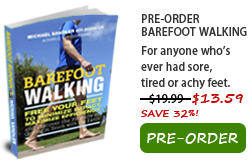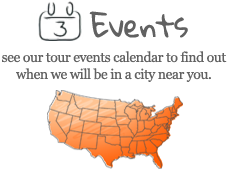The Challenges of Barefoot Running on Treadmills
~ By Michael Sandler
So, it’s the dead of Winter. The air temperature has finally climbed into the 40’s, but the ground's still as cold as ice. Plus, it looks like snow is in the forecast this week. “Wait, I’m not ready for barefoot running in snow!” you exclaim. The fact of the matter is we can’t always go barefoot when we want to, especially as beginners. And, that’s when you start eyeing that trusty treadmill.
Can you run barefoot on a treadmill? The answer is, “Yes,” and it’s not a bad idea if it’s the only way you can get barefoot running. But, please, please, please proceed with caution and consider the issues below before you get started.
Issue #1: The Treadmill Belt Comes at You
There are several mechanical challenges going on with a treadmill. Because it’s coming toward you, rather than you toward it, your mechanics often change from propulsion to deceleration. In other words, we find it hard to spring off of our toes, but instead often have force driving through our toes.
 Solution:
Solution:
You can help avoid this by decreasing speed, while increasing incline, naturally putting you up on your forefoot. Over the course of a run, you can gradually begin to decrease the incline and increase the pace. This way, you should still be able to spring off of your toes.
Issue #2: Running on a Treadmill is Running in a Tight Space
Personally, I find it difficult to keep up on my toes properly when it looks like I’ll land on the plastic in front of me.
Solution:
To overcome this, back up a good foot from where you’d normally run on the treadmill, to give your mind the space you need to stride correctly (chances are, it’s one of perception, NOT of reality, but your toes may think you don’t have enough room to come down correctly when you’re so close to the machine.) Trick here, make sure you can reach the control panel or safety rails and more importantly, make sure you’re not so far back you may wind up running off the machine.
Issue #3: Treadmills Lack Relief
There’s no relief on a treadmill. The surface, not the angle, is always perfectly flat. This means your feet don’t have natural relief in the terrain that lets one muscle group work a little more, and another rest a bit. In other words, when you’re on a dirt trail, or even all but the flattest of bike paths, your feet are constantly making small adjustments for the terrain, and these adjustments help prevent overuse fatigue by resting different muscles with each stride.
On a treadmill, there is no relief, so it’s quite common to develop an overuse injury running the SAME distance you were comfortable running outside. Why? Because step after step after step are IDENTICAL. The lack of relief can get you.
Solution:
So if you’re starting out on a treadmill, and since there are no ‘all-terrain’ treadmills in existence (at least not to my knowledge), vary the speed and incline as much as possible. For myself, I like changing the angle a little bit each minute. For instance, warm up for 3-5 minutes with the machine flat, then throw it up to a 7% to 10% grade, then with each minute, decrease the grade by 1% as you increase speed slightly. Another variation would be to have an interval setting where it changes the speed every minute – fast, then slow, then fast again.
Any change is good when you’re on a treadmill. Even if you’re focused on long, steady speed, steady on a treadmill can be dangerous until you’re ready.
Issue #4: Treadmill Belts Get Toasty
 Additionally, those belts are coarser than you think. When you’re running on a treadmill and sense something burning, LOOK DOWN. Chances are, it’s your pads (the thickened skin and fat deposits on the bottom of your foot).
Additionally, those belts are coarser than you think. When you’re running on a treadmill and sense something burning, LOOK DOWN. Chances are, it’s your pads (the thickened skin and fat deposits on the bottom of your foot).
Solution:
I’d recommend starting with 3-5 minutes your first day, and then adding a minute or two each day afterwards. If your pads are cooked, it’s likely you cooked everything beneath as well (muscles, tendons, ligaments).
Remember, even on a treadmill, stand tall, land on your forefoot, engage your core and take short natural steps. One of the keys to barefoot running and staying healthy isn’t stride length, but leg speed. Shorter, lighter strides always win when it comes to a lifetime of healthy, injury free running.
- Log in to post comments


